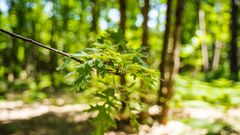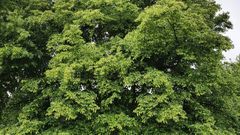

The Small-leaved linden (Tilia cordata), native to the temperate forests of Europe and Western Asia, is a majestic tree that occupies an important place in history and popular tradition. Appreciated for centuries for its heart-shaped foliage, delicate fragrance and medicinal flowers, this tree symbolises love, peace and conviviality. The Small-leaved linden is also a key component of forest ecosystems, promoting biodiversity thanks to its melliferous flowers and rich humus. Its longevity and resistance to climatic conditions make it a popular species for reforestation and sustainable forest management projects.
The Small-leaved linden is native to Europe and plays a crucial role in forest ecosystems.
Its flowers attract many pollinating insects, such as bees, thereby promoting local biodiversity. Its fruit is eaten by birds and small mammals, while its leaves serve as food for certain species of insect.
Once the lime leaves have fallen to the ground, they decompose rapidly, producing a rich humus that improves soil fertility.
The Small-leaved linden is a relatively drought-resistant species, which makes it well suited to a changing climate. As a result, it is better able to withstand water stress than other more sensitive forest species.
Thanks to its dense foliage, lime plays a role in regulating the microclimate in forests. It can help maintain higher relative humidity under the canopy, which is beneficial for more sensitive plants.
Small-leaved linden is particularly at home in mixed forests, where it can be combined with species such as oak, beech, hornbeam or maple. It favours an understorey rich in biodiversity thanks to its nourishing humus.
It is a shade-tolerant species, particularly when young. It can therefore thrive under dense forest cover, making it suitable for mixed forests or forest successions. However, when mature, it prefers a brighter exposure.
Tilia cordata is relatively slow-growing, especially in its early years. This is why it is often used in long-term plantations or mixed reforestation programmes, such as those set up in EcoTree forests.
Small-leaved linden is relatively resistant to disease and pests. However, it can be susceptible to certain pathologies, such aspowdery mildew (a fungus) which affects its leaves, as well as a few insects such as aphids and cynips (lime gall).
In general, these attacks are not serious enough to threaten the tree's survival, but they can temporarily affect its growth.
The wood of Small-leaved linden is renowned for its fine, soft and even texture. It is well suited to woodturning for making small decorative or functional objects such as bowls, bowls or utensils.
Basswood is often used in lutherie, particularly for making electric guitar bodies. Its lightness, stability and ability to absorb vibrations make it an excellent choice for certain types of stringed instrument. It is also used to make parts of lighter instruments, such as guitar and violin necks.
Small-leaved linden can be used to make pulp, although this is not its main use. Because of its lightness and low density, it is sometimes used to make matches, lightweight boxes and other similar products requiring a soft wood.
In addition to its wood, lime blossoms are used for their soothing and anti-inflammatory properties, and are commonly harvested to make infusions. They can also be used to treat anxiety and promote sleep.
In Greek mythology, the lime tree is associated with the story of Philemon and Baucis, an elderly couple whose hospitality to Zeus and Hermes, disguised as travellers, is rewarded by being transformed on their death into two intertwined trees: a lime tree and an oak. This legend reinforces the symbol of fidelity and eternal love in the lime tree.
Today, it is still associated withlove, particularly marital love and fidelity. Its branches are often seen as a symbol of the longevity and solidity of love relationships. What better gift than a Small-leaved linden for Valentine's Day?
Our goal is to enable anyone to do something that benefits nature and helps us to live in a more harmonious world. So why not become a tree owner in a European forest and help combat climate change?






Please note that this is promotional communication. See our notice of information.